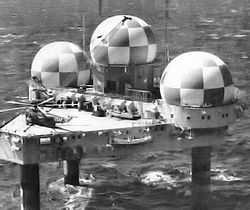Texas Towers
| Texas Tower | |
|---|---|
| Part of Air Defense Command (ADC) | |

|
|
| Type | Offshore air defense radar |
| Site information | |
| Condition | Out of service/demolished |
| Site history | |
| Built by |
|
| In use | 1958–1963 |
| Materials | Steel |
The Texas Towers were a set of three radar facilities off the eastern seaboard of the United States which were used for surveillance by the United States Air Force during the Cold War. Modeled on the offshore oil drilling platforms first employed off the Texas coast, they were in operation from 1958-1963. After the collapse of one of the towers in 1961, the remaining towers were closed due to changes in threat perception and out of a concern for the safety of the crews.
Upon re-formation of the Aerospace Defense Command in 1951 to oversee the nation's developing surveillance radar network, there was concern that shore-based radars along the east coast provided insufficient warning time. A 1952 report from MIT's Lincoln Laboratory looked into the possibility of extending radar coverage by building platforms in the Atlantic using offshore oil drilling technology. They concluded that a set of such platforms, equipped with radars, could extend coverage several hundred miles offshore, giving half an hour additional warning of an attack. Funding for design and construction of the towers was approved in January 1954.
Each tower consisted of a triangular platform, 200 feet on each side, standing on three caisson legs. The structures were constructed on land, towed to site, and jacked up to clear the sea surface by 67 feet. Radar and other equipment was then installed on location.
The platform itself contained two floors housing the living areas; two of the legs held fuel oil for diesel generators, while the third held the intake for the desalination unit. The platform roof served as a helicopter landing area. A rotary gantry was suspended from the platform to allow servicing of its underside.
Each platform was equipped with one AN/FPS-3 (later upgraded to AN/FPS-20) search radar and two AN/FPS-6 height finder radars, each housed in a separate spherical neoprene radome 55 feet in diameter. Originally the towers were to be linked to shore by submarine cable, but this was eventually rejected as too costly; the AN/FRC-56 tropospheric scatter microwave link was installed instead, with an array of three parabolic antennas attached to one edge of the platform. UHF and VHF equipment allowed communication with ships and aircraft as well as providing a backup to the microwave link.
...
Wikipedia

